Modeling, which is based on cutting patterns into parts, can solve several problems.
1) Artistic tasks - this item does not require explanation, see an example in photo 1.
2) Simplification of sewing technology, for example, through the combination of parts.
My favorite example is classic jeans: the PP tuck is aligned with the pocket entry line, and the two ZP tucks are “closed” with a yoke.
Thus, the tailoring technology is reduced.
3) Saving fabric and/or other consumables.
Again, you have to cite jeans as an example: due to the cut line of the coquette, the consumption of fabric per unit has decreased by about 5 cm.
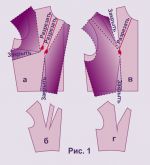 4) Bringing the tailoring technology in line with the characteristics of the fabric.
4) Bringing the tailoring technology in line with the characteristics of the fabric.
Let's say you cut from clothes leatherette - avoid darts, give preference to reliefs.
Chiffon models should also avoid darts whenever possible (see example)
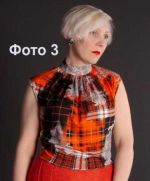 5) Giving strength to individual units or parts of the product.
5) Giving strength to individual units or parts of the product.
This can be seen on men's shirts - the displacement of the shoulder seam due to the yoke, which is often doubled.
Or processing a pocket in a yoke seam (see example and free pattern).
6) Visual correction of the figure by adding horizontal or vertical modeling lines and / or contrasting details.
Example in photo 2
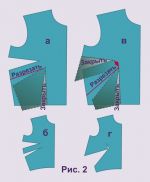 Now let's look at the methods by which these tasks are solved using examples. simple cutting patterns of the adjacent bodice.
Now let's look at the methods by which these tasks are solved using examples. simple cutting patterns of the adjacent bodice.
Rule. Any pattern can be cut into any number of pieces.
In the vast majority of cases, modeling is performed on base with chest tuck, less often base with side tuck.
In recent years, modeling has become widespread stretch-based и "kimono"... Cm. an example of asymmetric modeling of the "kimono" base
Transfer of bust tuck to waist tuck (see "Working with patterns" rice. 7) - one of the most common for sizes up to 48th.
Widely used for vests.
Patterns of vests and blouses, jackets
1a - the number of new (transferred) darts can be any and depends on the number of cuts from the neck to the tops of the darts available on the basis,
1b - the result of two cuts from the neck to the tops of the side and waist darts.
You can make one cut from the neck to the top of the chest tuck,
and from it to the top of the waist - 1v and the result after both tucks are closed and transferred to the neck is shown 1d.
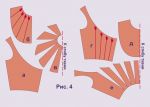 Usually, the method presented in figures 1c - 1d,
Usually, the method presented in figures 1c - 1d,
use if you need an assembly around the neck (see an example in photo 3).
Rice. 2 - transfer of darts to the side seam - at this stage, modeling can be completed or continued (Fig. 3).
Usually, they don’t transfer darts into the side seam just like that, since such bodices do not represent “artistic” value, and the volume of the waist tuck can simply be “cut off” from the side seam.
In addition, there is base with semi-relief from the side seam (straight, rounded, with an angle).
 The only "justification" for such a transfer - 2g - can be sewing a product from a striped or checkered fabric.
The only "justification" for such a transfer - 2g - can be sewing a product from a striped or checkered fabric.
So, the continuation of the modeling of the tucks transferred to the side seam can be used for a lace or contrasting insert - 3a, for assembly along the top line of the tuck - 3b, 3c.
Rice. 4 a-b and 5 a-b - transfer of the chest tuck to the yoke.
Simulation can be continued: Fig. 4c, 5c - to get folds or gathers along the cut line of the yoke, the part of the yoke is cut, and the “petals” are moved apart.
If assembly or storage under the yoke is needed, the shelf should be cut - Fig. 4th, 5th.
 Rice. 6 - transfer of tucks to a half skid - used for assembly along the middle seam.
Rice. 6 - transfer of tucks to a half skid - used for assembly along the middle seam.
As you can see, it doesn't matter which base you use.



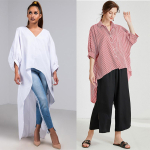
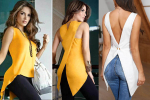


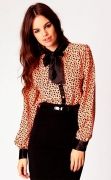

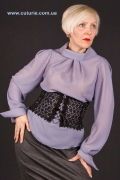


 Join my community on Viber...
Join my community on Viber...











